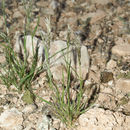Comments
provided by eFloras
This species is one of the most widespread in the genus and is the only one to develop cleistogamous spikelets within the basal leaf sheaths. Mature grains can often be found at the base of the plant.
- license
- cc-by-nc-sa-3.0
- copyright
- Missouri Botanical Garden, 4344 Shaw Boulevard, St. Louis, MO, 63110 USA
Description
provided by eFloras
Perennial. Culms densely tufted, wiry, usually geniculate at base, 5–35 cm tall, pubescent. Basal leaf sheaths tough, whitish, enclosing cleistogamous spikelets, finally becoming fibrous; leaf blades usually involute, filiform, 2–12 cm, 1–3 mm wide, densely pubescent or the abaxial surface with longer white soft hairs, finely acuminate. Panicle gray, dense, spikelike, linear to ovate, 1.5–5 × 0.6–1 cm. Spikelets with 3 florets, 5.5–7 mm; glumes pubescent, 3–9-veined, lower glume 3–3.5 mm, upper glume 4–5 mm; lowest lemma 1.5–2 mm, densely villous; awns 2–4 mm, subequal, ciliate in lower 2/3 of their length; third lemma 0.5–3 mm, reduced to a small tuft of awns. Anthers 0.3–0.6 mm. Fl. and fr. Aug–Nov. 2n = 36.
- license
- cc-by-nc-sa-3.0
- copyright
- Missouri Botanical Garden, 4344 Shaw Boulevard, St. Louis, MO, 63110 USA
Distribution
provided by eFloras
Anhui, Gansu, Hebei, Liaoning, Nei Mongol, Ningxia, Qinghai, Shanxi, Xinjiang, Yunnan [India, Kazakhstan, Kyrgyzstan, Mongolia, Pakistan, E Russia; Africa, America, SW Asia].
- license
- cc-by-nc-sa-3.0
- copyright
- Missouri Botanical Garden, 4344 Shaw Boulevard, St. Louis, MO, 63110 USA
Synonym
provided by eFloras
Enneapogon borealis (Grisebach) Honda; E. brachysta-chyus (Jaubert & Spach) Stapf; E. desvauxii subsp. borealis (Grisebach) Tzvelev; E. jinjiangensis B. S. Sun & S. Wang; Pappophorum boreale Grisebach; P. brachystachyum Jaubert & Spach.
- license
- cc-by-nc-sa-3.0
- copyright
- Missouri Botanical Garden, 4344 Shaw Boulevard, St. Louis, MO, 63110 USA
Physical Description
provided by USDA PLANTS text
Perennials, Terrestrial, not aquatic, Basal sheaths fibrous, old leaves persistent at base of plant, Stems nodes swollen or brittle, Stems erect or ascending, Stems geniculate, decumbent, or lax, sometimes rooting at nodes, Stems caespitose, tufted, or clustered, Stems terete, round in cross section, or polygonal, Stems branching above base or distally at nodes, Stem nodes bearded or hairy, Stem internodes hollow, Stems with inflorescence less than 1 m tall, Stems, culms, or scapes exceeding basal leaves, Leaves mostly basal, below middle of stem, Leaves mostly cauline, Leaves conspicuously 2-ranked, distichous, Leaves sheathing at base, Leaf sheath mostly open, or loose, Leaf sheath hairy, hispid or prickly, Leaf sheath and blade differentiated, Leaf blades linear, Leaf blades very narrow or filiform, less than 2 mm wide, Leaf blade margins folded, involute, or conduplicate, Leaf blades more or less hairy, Ligule present, Ligule a fringe of hairs, Inflorescence terminal, Inflorescence a dense slender spike-like panicle or raceme, branches contracted, Inflorescence solitary, with 1 spike, fascicle, glomerule, head, or cluster per stem or culm, Flowers bisexual, Spikelets pedicellate, Spikelets laterally compressed, Spikelet less than 3 mm wide, Spikelets with 1 fertile floret, Spikelets solitary at rachis nodes, Spikelets all alike and fertille, Spikelets bisexual, Spikelets disarticulating above the glumes, glumes persistent, Spikelets disarticulating beneath or between the florets, Rachilla or pedicel glabrous, Glumes present, empty bracts, Glumes 2 clearly present, Glumes equal or subequal, Glumes equal to or longer than adjacent lemma, Glumes 3 nerved, Glumes 4-7 nerved, Glumes 8-15 nerved, Lemmas thin, chartaceous, hyaline, cartilaginous, or membranous, Lemma 8-15 nerved, Lemma body or surface hairy, Lemma apex dentate, 3-5 fid, Lemma distinctly awned, more than 2-3 mm, Lemma with 7-15 awns, Lemma awns about equal in length, Lemma awn less than 1 cm long, Lemma awns straight or curved to base, Lemma margins thin, lying flat, Lemma straight, Lemma surface pilose, setose or bristly, Palea present, well developed, Palea membranous, hyaline, Palea longer than lemma, Palea 2 nerved or 2 keeled, Stamens 3, Styles 2-fid, deeply 2-branched, Stigmas 2, Fruit - caryopsis, Caryopsis ellipsoid, longitudinally grooved, hilum long-linear.
Enneapogon desvauxii: Brief Summary
provided by wikipedia EN
Enneapogon desvauxii is a species of grass known by the common name nineawn pappusgrass. This is a short perennial bunchgrass native to the southwestern United States, northern Mexico, parts of South America, and occurs throughout arid parts of Africa. It is known less often on other continents.
- license
- cc-by-sa-3.0
- copyright
- Wikipedia authors and editors

